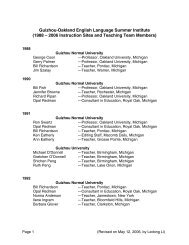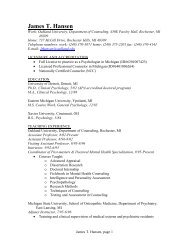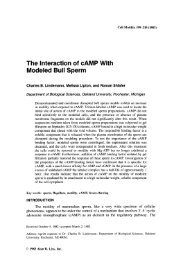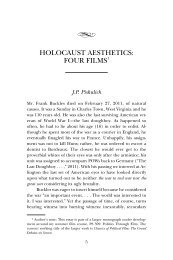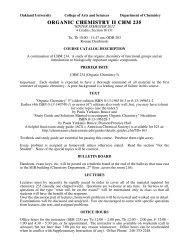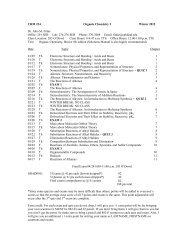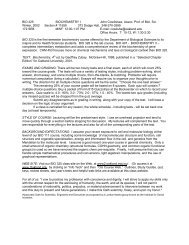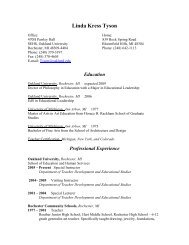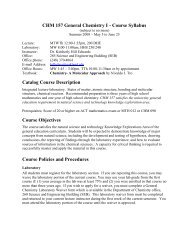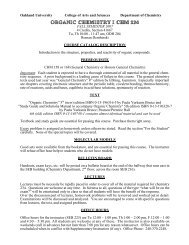mRNA Chapter 5
mRNA Chapter 5
mRNA Chapter 5
You also want an ePaper? Increase the reach of your titles
YUMPU automatically turns print PDFs into web optimized ePapers that Google loves.
<strong>mRNA</strong><br />
<strong>Chapter</strong> 5<br />
By<br />
Rasul Chaudhry
Messenger RNA (<strong>mRNA</strong>) is the<br />
intermediate that represents one strand<br />
of a gene coding for protein. Its coding<br />
region is related to the protein sequence<br />
by the triplet genetic code.<br />
Transfer RNA (tRNA) is the<br />
intermediate in protein synthesis that<br />
interprets the genetic code. Each tRNA<br />
can be linked to an amino acid. The<br />
tRNA has an anticodon sequence that<br />
complementary to a triplet codon<br />
representing the amino acid.<br />
Ribosomal RNA (rRNA) is a major<br />
component of the ribosome. Each of the<br />
two subunits of the ribosome has a<br />
major rRNA as well as many proteins.
The coding function of <strong>mRNA</strong> is unique, but<br />
tRNA and rRNA are examples of a much<br />
broader class of noncoding RNAs with a variety<br />
of functions in gene expression.
• Transcription describes synthesis of RNA on a<br />
DNA template.<br />
• Translation is synthesis of protein on an <strong>mRNA</strong><br />
template.<br />
• A coding region is a part of the gene that represents<br />
a protein sequence.<br />
• The antisense strand (Template strand) of DNA is<br />
complementary to the sense strand, and is the one<br />
that acts as the template for synthesis of <strong>mRNA</strong>.<br />
• The coding strand (Sense strand) of DNA has the<br />
same sequence as the <strong>mRNA</strong> and is related by the<br />
genetic code to the protein sequence that it<br />
represents.
• Transfer RNA (tRNA) is the intermediate in protein synthesis that interprets the genetic code. Each<br />
tRNA can be linked to an amino acid. The tRNA has an anticodon sequence that complementary to a<br />
triplet codon representing the amino acid.<br />
• The anticodon is a trinucleotide sequence in tRNA which is complementary to the codon in <strong>mRNA</strong> and<br />
enables the tRNA to place the appropriate amino acid in response to the codon.<br />
• The cloverleaf describes the structure of tRNA drawn in two dimensions, forming four distinct armloops.<br />
• A stem is the base-paired segment of a hairpin structure in RNA.<br />
• A loop is a single-stranded region at the end of a hairpin in RNA (or single-stranded DNA); it<br />
corresponds to the sequence between inverted repeats in duplex DNA.<br />
• An arm of tRNA is one of the four (or in some cases five) stem-loop structures that make up the<br />
secondary structure.<br />
• The acceptor arm of tRNA is a short duplex that terminates in the CCA sequence to which an amino<br />
acid is linked.<br />
• The anticodon arm of tRNA is a stem loop structure that exposes the anticodon triplet at one end.<br />
• The D arm of tRNA has a high content of the base dihydrouridine.<br />
• The extra arm of tRNA lies between the TyC and anticodon arms. It is the most variable in length in<br />
tRNA, from 3-21 bases. tRNAs are called class 1 if they lack it, and class 2 if they have it.<br />
• Invariant base positions in tRNA have the same nucleotide in virtually all (>95%) of tRNAs.<br />
• Conserved sequences are identified when many examples of a particular nucleic acid or protein are<br />
compared and the same individual bases or amino acids are always found at particular locations.<br />
• A semiconserved (Semiinvariant) position is one where comparison of many individual sequences finds<br />
the same type of base (pyrimidine or purine) always present.<br />
• An aminoacyl-tRNA is a tRNA linked to an amino acid. The COOH group of the amino acid is linked to<br />
the 3′- or 2′-OH group of the terminal base of the tRNA.<br />
• Aminoacyl-tRNA synthetases are enzymes responsible for covalently linking amino acids to the 2′- or<br />
3′-OH position of tRNA.
A tRNA has two crucial properties:<br />
It represents a single amino acid, to which it is<br />
covalently linked.<br />
It contains a trinucleotide sequence, the anticodon,<br />
which is complementary to the codon representing its<br />
amino acid. The anticodon enables the tRNA to<br />
recognize the codon via complementary base pairing<br />
• The tRNA secondary structure can<br />
be written in the form of a<br />
cloverleaf structure, in which<br />
complementary base pairing forms<br />
stems for single-stranded loops.<br />
The stem-loop structures are called<br />
the arms of tRNA. Their sequences<br />
include "unusual" bases that are<br />
generated by modification of the 4<br />
standard bases after synthesis of the<br />
polynucleotide chain
• The acceptor arm consists of a<br />
base-paired stem that ends in an<br />
unpaired sequence whose free 2′–<br />
or 3′–OH group can be linked to an<br />
amino acid.<br />
• The TψC armis named for the<br />
presence of this triplet sequence. (ψ<br />
stands for pseudouridine, a<br />
modified base.)<br />
• The anticodon arm always<br />
contains the anticodon triplet in the<br />
center of the loop.<br />
• The D arm is named for its content<br />
of the base dihydrouridine (another<br />
of the modified bases in tRNA).<br />
• The extra arm lies between the<br />
TψC and anticodon arms and varies<br />
from 3-21 bases.
• When a tRNA is charged with<br />
the amino acid corresponding to<br />
its anticodon, it is called<br />
aminoacyl-tRNA. The amino<br />
acid is linked by an ester bond<br />
from its carboxyl group to the 2′<br />
or 3′ hydroxyl group of the<br />
ribose of the 3′ terminal base of<br />
the tRNA (which is always<br />
adenine). The process of<br />
charging a tRNA is catalyzed by<br />
a specific enzyme, aminoacyltRNA<br />
synthetase. There are (at<br />
least) 20 aminoacyl-tRNA<br />
synthetases. Each recognizes a<br />
single amino acid and all the<br />
tRNAs on to which it can<br />
legitimately be placed.<br />
Charging of<br />
tRNA
• The base paired double-helical stems of<br />
the secondary structure are maintained in<br />
the tertiary structure, but their<br />
arrangement in three dimensions<br />
essentially creates two double helices at<br />
right angles to each other, as illustrated in<br />
Figure 5.6. The acceptor stem and the<br />
TψC stem form one continuous double<br />
helix with a single gap; the D stem and<br />
anticodon stem form another continuous<br />
double helix, also with a gap. The region<br />
between the double helices, where the<br />
turn in the L-shape is made, contains the<br />
TψC loop and the D loop. So the amino<br />
acid resides at the extremity of one arm of<br />
the L-shape, and the anticodon loop forms<br />
the other end.
The ribosome is a large assembly of RNA and proteins that synthesizes<br />
proteins under direction from an <strong>mRNA</strong> template. Bacterial ribosomes<br />
sediment at 70S, eukaryotic ribosomes at 80S. A ribosome can be<br />
dissociated into two subunits.<br />
A ribonucleoprotein is a complex of RNA with proteins.<br />
The large subunit of the ribosome<br />
(50S in bacteria, 60S in eukaryotes)<br />
has the peptidyl transferase active<br />
site that synthesizes the peptide<br />
bond.<br />
The small subunit of the ribosome<br />
(30S in bacteria, 40S in eukaryotes)<br />
binds the <strong>mRNA</strong>.
A polyribosome (Polysome) is an <strong>mRNA</strong> that is<br />
simultaneously being translated by several ribosomes.<br />
A nascent protein has not yet completed its synthesis;<br />
the polypeptide chain is still attached to the ribosome via<br />
a tRNA.<br />
Fig.5.9
Globin protein is synthesized by a set of 5 ribosomes attached to each<br />
<strong>mRNA</strong> (pentasomes). The ribosomes appear as squashed spherical<br />
objects of ~7 nm (70 Å) in diameter, connected by a thread of <strong>mRNA</strong>.<br />
The ribosomes are located at various positions along the messenger.<br />
Those at one end have just started protein synthesis; those at the other<br />
end are about to complete production of a polypeptide chain.<br />
The size of the polysome depends on several<br />
variables. In bacteria, it is very large, with<br />
tens of ribosomes simultaneously engaged in<br />
translation. Partly the size is due to the<br />
length of the <strong>mRNA</strong> (which usually codes<br />
for several proteins); partly it is due to the<br />
high efficiency with which the ribosomes<br />
attach to the <strong>mRNA</strong>.<br />
Fig. 5.10<br />
Polysomes in the cytoplasm of a eukaryotic<br />
cell are likely to be smaller than those in<br />
bacteria; again, their size is a function both<br />
of the length of the <strong>mRNA</strong> (usually<br />
representing only a single protein in<br />
eukaryotes) and of the characteristic<br />
frequency with which ribosomes attach. An<br />
average eukaryotic <strong>mRNA</strong> probably has ~8<br />
ribosomes attached at any one time.
The 20,000 or so ribosomes account for a quarter of the cell mass. There a<br />
outnumber the ribosomes by almost tenfold; most of them are present as am<br />
Because of their instability, it is difficult to calculate the number of <strong>mRNA</strong><br />
synthesis and decomposition. There are ~600 different types of <strong>mRNA</strong> in<br />
<strong>mRNA</strong> per bacterium. On average, each probably codes for ~3 proteins. If<br />
copies of each protein in a bacterium.<br />
Fig. 5.12
Fig. 5.13<br />
Nascent RNA is a ribonucleotide chain that is still<br />
being synthesized, so that its 3′ end is paired with<br />
DNA where RNA polymerase is elongating.<br />
Monocistronic <strong>mRNA</strong> codes for one protein.<br />
Polycistronic <strong>mRNA</strong> includes coding regions<br />
representing more than one gene.<br />
A coding region is a part of the gene that<br />
represents a protein sequence.<br />
The leader (5′ UTR) of an <strong>mRNA</strong> is the<br />
nontranslated sequence at the 5′ end that precedes<br />
the initiation codon.<br />
A trailer (3′ UTR) is a nontranslated sequence at<br />
the 3′ end of an <strong>mRNA</strong> following the termination<br />
codon.<br />
The intercistronic region is the distance between<br />
the termination codon of one gene and the<br />
initiation codon of the next gene.
•Bacterial transcription and translation take place at similar rates. At 37°C, transcription<br />
of <strong>mRNA</strong> occurs at ~40 nucleotides/second. This is very close to the rate of protein<br />
synthesis, roughly 15 amino acids/second. It therefore takes ~2 minutes to transcribe<br />
and translate an <strong>mRNA</strong> of 5000 bp, corresponding to 180 kD of protein. When<br />
expression of a new gene is initiated, its <strong>mRNA</strong> typically will appear in the cell within<br />
~2.5 minutes. The corresponding protein will appear within perhaps another 0.5 minute.<br />
Bacterial translation is very efficient, and most <strong>mRNA</strong>s are translated by a large<br />
number of tightly packed ribosomes. . In one example (trp(<br />
<strong>mRNA</strong>), about 15<br />
initiations of transcription occur every minute, and each of the 15 <strong>mRNA</strong>s<br />
probably is translated by ~30 ribosomes in the interval between its transcription<br />
and degradation.<br />
The instability of most bacterial<br />
<strong>mRNA</strong>s is striking. Degradation of<br />
<strong>mRNA</strong> closely follows its<br />
translation. Probably it begins<br />
within 1 minute of the start of<br />
transcription.<br />
Fig. 5.14
A polycistronic <strong>mRNA</strong> also contains intercistronic regions, as<br />
illustrated in Figure 5.15. . They vary greatly in size. They may<br />
be as long as 30 nucleotides in bacterial <strong>mRNA</strong>s (and even<br />
longer in phage RNAs), but they can also be very short, with<br />
as few as 1 or 2 nucleotides separating the termination codon<br />
for one protein from the initiation codon for the next. In an<br />
extreme case, two genes actually overlap, so that the last<br />
base of one coding region is also the first base of the next<br />
coding region.
Fig. 5.16<br />
•Poly(A) is a stretch of ~200 bases of adenylic acid that is<br />
added to the 3′ end of <strong>mRNA</strong> following its synthesis.
i<br />
Only<br />
o<br />
after the completion of all modification and processing events can<br />
the<br />
n<br />
<strong>mRNA</strong> be exported from the nucleus to the cytoplasm. The average<br />
delay in leaving for the cytoplasm is ~20 minutes. Once the <strong>mRNA</strong> has<br />
entered<br />
o<br />
the cytoplasm, it is recognized by ribosomes and translated.<br />
Figure 5.17 shows that the life cycle of eukaryotic <strong>mRNA</strong> is<br />
f<br />
more protracted than that of bacterial <strong>mRNA</strong>. Transcription<br />
in animal cells occurs at about the same speed as in bacteria,<br />
~40 nucleotides per second. Many eukaryotic genes are large;<br />
m<br />
R<br />
N<br />
A<br />
a gene of 10,000 bp takes ~5 minutes to transcribe.<br />
Transcription of <strong>mRNA</strong> is not terminated by the release of<br />
enzyme from the DNA; instead the enzyme continues past the<br />
end of the gene. A coordinated series of events generates the 3′<br />
end of the <strong>mRNA</strong> by cleavage, and adds a length of poly(A) to<br />
the newly generated 3′ end.<br />
i<br />
s<br />
Eukaryotic <strong>mRNA</strong> constitutes only a small proportion of the<br />
total cellular RNA (~3% of the mass). Half-lives are relatively<br />
short in yeast, ranging from 1-60 minutes. There is a<br />
substantial increase in stability in higher eukaryotes; animal<br />
cell <strong>mRNA</strong> is relatively stable, with half-lives ranging from 4-<br />
n<br />
o<br />
t<br />
24 hours.<br />
Eukaryotic polysomes are reasonably stable. The<br />
modifications at both ends of the <strong>mRNA</strong> contribute to the<br />
stability.
A cap is the structure at the 5′ end of eukaryotic <strong>mRNA</strong>, introduced after<br />
transcription by linking the terminal phosphate of 5′ GTP to the terminal<br />
base of the <strong>mRNA</strong>. The added G (and sometimes some other bases) are<br />
methylated, giving a structure of the form 7MeG5′ppp5′Np . . .<br />
A cap 0 at the 5′ end of <strong>mRNA</strong> has only a methyl group on 7-guanine.<br />
A cap 1 at the 5′ end of <strong>mRNA</strong> has methyl groups on the terminal 7-<br />
guanine and the 2′-O position of the next base.<br />
A cap 2 has three methyl<br />
groups (7-guanine, 2′-O<br />
position of next base, and N6<br />
adenine) at the 5′ end of<br />
<strong>mRNA</strong>.
• Transcription starts with a nucleoside triphosphate (usually a purine, A or G). The<br />
initial sequence of the transcript can be represented as:<br />
•<br />
• 5′pppA/GpNpNpNp...<br />
•<br />
• Addition of the 5′ terminal G is catalyzed by a nuclear enzyme, guanylyl transferase.<br />
The reaction occurs so soon after transcription has started that it is not possible to<br />
detect more than trace amounts of the original 5′ triphosphate end in the nuclear<br />
RNA. The overall reaction<br />
•<br />
• 5′ 5′<br />
•<br />
• Gppp + pppApNpNp...<br />
•<br />
• ↓<br />
•<br />
• 5′–– 5′<br />
•<br />
• GpppApNpNp... + pp + p<br />
•<br />
• The new G residue added to the end of the RNA is in the reverse orientation from all<br />
the other nucleotides.
• The first methylation occurs in all eukaryotes, and consists of the<br />
addition of a methyl group to the 7 position of the terminal guanine. A<br />
cap that possesses this single methyl group is known as a cap 0. This<br />
is as far as the reaction proceeds in unicellular eukaryotes. The<br />
enzyme responsible for this modification is called guanine-7-<br />
methyltransferase.<br />
• The next step is to add another methyl group, to the 2′–O position of<br />
the penultimate base (which was actually the original first base of the<br />
transcript before any modifications were made). This reaction is<br />
catalyzed by another enzyme (2′–O-methyl-transferase). A cap with<br />
the two methyl groups is called cap 1. This is the predominant type of<br />
cap in all eukaryotes except unicellular organisms.<br />
• In a small minority of cases in higher eukaryotes, another methyl<br />
group is added to the second base. This happens only when the<br />
position is occupied by adenine; the reaction involves addition of a<br />
methyl group at the N6 position. The enzyme responsible acts only on<br />
an adenosine substrate that already has the methyl group in the 2′–O<br />
position.
• In some species, a methyl group is added to the third base of<br />
the capped <strong>mRNA</strong>. The substrate for this reaction is the cap<br />
1 <strong>mRNA</strong> that already possesses two methyl groups. The<br />
third-base modification is always a 2′–O ribose methylation.<br />
This creates the cap 2 type. This cap usually represents less<br />
than 10-15% of the total capped population.<br />
• In addition to the methylation involved in capping, a low<br />
frequency of internal methylation occurs in the <strong>mRNA</strong> only<br />
of higher eukaryotes. This is accomplished by the<br />
generation of N6 methyladenine residues at a frequency of<br />
about one modification per 1000 bases. There are 1-2<br />
methyladenines in a typical higher eukaryotic <strong>mRNA</strong>,<br />
although their presence is not obligatory.
3’-Adenylation<br />
• poly(A)+ <strong>mRNA</strong> is <strong>mRNA</strong> that has<br />
a 3′ terminal stretch of poly(A).<br />
• Poly(A) polymerase is the enzyme<br />
that adds the stretch of polyadenylic<br />
acid to the 3′ of eukaryotic <strong>mRNA</strong>.<br />
It does not use a template.<br />
• Poly(A)-binding protein (PABP)<br />
is the protein that binds to the 3′<br />
stretch of poly(A) on a eukaryotic<br />
<strong>mRNA</strong>.<br />
• cDNA is a single-stranded DNA<br />
complementary to an RNA,<br />
synthesized from it by reverse<br />
transcription in vitro.<br />
• poly(A)- <strong>mRNA</strong> is <strong>mRNA</strong> that has<br />
does not have a 3′ terminal stretch<br />
of poly(A).<br />
The presence of poly(A) has an<br />
important practical consequence
The degradosome is a complex of bacterial<br />
enzymes, including RNAase and helicase<br />
activities, which may be involved in degrading<br />
<strong>mRNA</strong>.<br />
There are ~12 ribonucleases in E. coli.<br />
Mutants in the endoribonucleases (except<br />
ribonuclease I, which is without effect)<br />
accumulate unprocessed precursors to rRNA<br />
and tRNA, but are viable. Mutants in the<br />
exonucleases often have apparently<br />
unaltered phenotypes, which suggests that<br />
one enzyme can substitute for the absence of<br />
another. Mutants lacking multiple enzymes<br />
sometimes are inviable
• RNAase E is the key enzyme in initiating cleavage of <strong>mRNA</strong>. It may<br />
be the enzyme that makes the first cleavage for many <strong>mRNA</strong>s.<br />
Bacterial mutants that have a defective ribonuclease E have increased<br />
stability (2-3 fold) of <strong>mRNA</strong>. However, this is not its only function.<br />
RNAase E was originally discovered as the enzyme that is responsible<br />
for processing 5′ rRNA from the primary transcript by a specific<br />
endonucleolytic processing event.<br />
• Degradosome includes ribonuclease E, PNPase, and a helicase.<br />
• Polyadenylation may play a role in initiating degradation of some<br />
<strong>mRNA</strong>s in bacteria. Poly(A) polymerase is associated with ribosomes<br />
in E. coli, and short (10-40 nucleotide) stretches of poly(A) are added<br />
to at least some <strong>mRNA</strong>s. Triple mutations that remove poly(A)<br />
polymerase, ribonuclease E, and polynucleotide phosphorylase<br />
(PNPase is a 3′–5′ exonuclease) have a strong effect on stability.<br />
• The role of poly(A) in bacteria would therefore be different from that<br />
in eukaryotic cells.
• The modifications at both ends of <strong>mRNA</strong> protect it against<br />
degradation by exonucleases.<br />
• Specific sequences within an <strong>mRNA</strong> may have stabilizing<br />
or destabilizing effects.<br />
• Destabilization may be triggered by loss of poly(A)
• A common feature in some unstable <strong>mRNA</strong>s is the presence<br />
of an AU-rich sequence of ~50 bases (called the ARE) that<br />
is found in the 3′ trailer region. The consensus sequence in<br />
the ARE is the pentanucleotide AUUUA, repeated several<br />
times. Figure 5.22 shows that the ARE triggers<br />
destabilization by a two stage process: first the <strong>mRNA</strong> is<br />
deadenylated; then it<br />
• decays. The deadenylation<br />
• is probably needed<br />
• because it causes loss of<br />
• the poly(A)-binding<br />
• protein, whose presence<br />
• stabilizes the 3′ region
• Transferrin <strong>mRNA</strong> contains a sequence called the IRE,<br />
which controls the response of the <strong>mRNA</strong> to changes in iron<br />
concentration. The IRE is located in the 3′ nontranslated<br />
region, and contains stem-loop structures that bind a protein<br />
whose affinity for the <strong>mRNA</strong> is controlled by iron.
• RNA is transported through a membrane as a<br />
ribonucleoprotein particle.<br />
• All eukaryotic RNAs that function in the cytoplasm must be<br />
exported from the nucleus.<br />
• tRNAs and the RNA component of a ribonuclease are<br />
imported into mitochondria.<br />
• <strong>mRNA</strong>s can travel long distances between plant cells.



